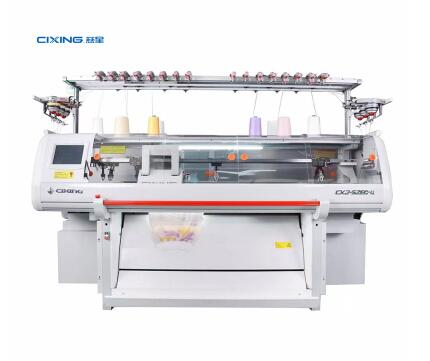The Benefits of Using a Flat Knitting Machine Over Other Knitting Methods
2024-10-11
Knitting has evolved significantly over the years, with various methods offering different advantages. Among them, the flat knitting machine stands out for its versatility, efficiency, and high-quality results. Whether you're producing garments, home textiles, or technical fabrics, flat knitting machines offer distinct advantages over traditional hand knitting and circular knitting methods. This blog will explore the key benefits of using a flat knitting machine.
1. Precision and Customization
One of the primary advantages of flat knitting machines is their ability to produce garments and fabrics with high precision. These machines allow for accurate control of stitches, tension, and patterns, resulting in consistent and flawless fabric quality. This level of precision makes it possible to create highly customized designs with intricate patterns, textures, and shaping that may be difficult or time-consuming to achieve by hand.
- Complex patterns such as cables, intarsia, and jacquard can be easily programmed and produced without errors.
- Custom fitting: Flat knitting machines are ideal for creating garments with specific shapes and sizes, providing a better fit for fashion and technical applications.
2. Faster Production
Compared to hand knitting or other knitting techniques, flat knitting machines offer a much faster production speed. This speed advantage makes them highly valuable in industrial and commercial settings where time is a critical factor.
- Increased output: A flat knitting machine can produce large quantities of fabric or garments in a fraction of the time it would take using manual methods.
- Efficiency in batch production: When working on multiple pieces of a similar design, a flat knitting machine can repeat patterns automatically, saving time and labor.
3. Versatility of Materials
Flat knitting machines are versatile and can work with a wide range of materials, from natural fibers like cotton and wool to synthetic fibers like nylon and polyester. This adaptability allows for the creation of a variety of products, from everyday garments to highly technical fabrics used in industries like sports, medicine, and automotive.
- Blend of materials: The machine can easily handle blends of different yarns, which is useful for creating fabrics with mixed properties such as stretch, durability, and moisture-wicking.
- Technical textiles: Flat knitting machines are increasingly used for producing smart textiles and wearable technology due to their ability to integrate sensors and conductive fibers.

4. Seamless Garment Production
Flat knitting machines have the ability to create seamless or nearly seamless garments, a significant advantage in fashion production. This reduces the need for additional cutting and sewing, leading to a more streamlined production process.
- Better comfort: Seamless garments are more comfortable to wear, as they eliminate uncomfortable seams and reduce irritation.
- Reduced waste: By producing garments without seams, manufacturers can significantly reduce fabric waste, making the process more sustainable.
- Aesthetic appeal: Seamless garments have a sleek, modern appearance, which is highly desirable in many fashion markets.
5. Sustainability
Sustainability is becoming increasingly important in the textile and fashion industries. Flat knitting machines contribute to more sustainable production in several ways:
- Minimal waste: Since flat knitting machines create the fabric in the exact shape needed for garments, there is minimal leftover material, reducing waste.
- Energy efficiency: Modern flat knitting machines are designed to use less energy compared to older machines or traditional knitting methods, reducing the environmental impact.
- On-demand production: With the ability to create custom pieces quickly and efficiently, flat knitting machines support a more sustainable approach to production by reducing overproduction and excess inventory.
6. Cost-Effective in the Long Run
While the initial investment in a flat knitting machine may be high, the long-term cost savings make it a valuable tool for businesses. The speed, precision, and efficiency of these machines reduce labor costs and increase output, leading to higher profit margins.
- Lower labor costs: Automation reduces the need for manual labor, and fewer errors mean less time spent on corrections and alterations.
- Fewer material losses: With precise control over fabric dimensions, there is less waste of expensive materials.
- Quick design changes: With the ability to quickly change or update designs, companies can adapt to trends more rapidly without incurring additional costs.
7. 3D Knitting Capabilities
Many modern flat knitting machines offer 3D knitting capabilities, allowing the production of fully shaped, three-dimensional pieces directly from the machine. This is particularly beneficial for applications such as footwear, sports gear, and even medical supports like compression sleeves.
- Shaped garments: The machine can produce garments that conform to the body's contours without needing additional assembly, offering a superior fit.
- Technical applications: 3D knitting allows for the creation of advanced textiles, such as reinforced areas for added strength in specific sections or breathable zones in garments.
8. Easy Integration with Digital Design Tools
Many flat knitting machines come equipped with digital interfaces that allow for seamless integration with computer-aided design (CAD) systems. This means designers can easily translate their digital designs into physical products without extensive manual intervention.
- Automation: Patterns, textures, and customizations can be programmed into the machine, ensuring a precise outcome every time.
- Quick prototyping: Designers can test out multiple iterations of a design rapidly without waiting for lengthy production times, allowing for faster market entry.
Conclusion
The flat knitting machine offers numerous advantages over traditional knitting methods, from faster production times and higher precision to more sustainable manufacturing practices. Whether you're in the fashion industry, textile manufacturing, or technical applications, a flat knitting machine can help improve efficiency, reduce waste, and enhance the quality of your products. By investing in this technology, companies can remain competitive in the rapidly evolving textile market while meeting modern demands for speed, customization, and sustainability.


